In the footsteps of the exhibition Eurosatory 2016: trends in the development of armored vehicles. Part of 3
Patria has recently introduced the XP version of its modular armored AMV. In the photo, a car with a turret armed with a medium-caliber gun, which turns it into an infantry fighting vehicle
The largest customer of the Armored Modular Vehicle (AMV) modular armored vehicle developed by the Finnish company Patria is Poland; A total of 997 machines were ordered in several batches, which received the designation Rosomak there. The Rosomak armored vehicle is manufactured under license in a Polish factory, based on the basic version, several modifications were made, in addition, new models were developed. Poland has announced that it will order a new RAK mortar tower with an 120-mm mortar, which will be installed on 64 machines, developed by Huta Stalowa Wola, while Rosomak 32 machines will be converted into control units for mortar units; thus, eight companies will be formed, which will become part of the mechanized battalions. In search of replacing their BMPs with the Ratel wheel formula 6x6, South Africa began national development, but in 2013, it decided to sign an agreement with Patria to use the AMV machine as the basis for the new machine. The car received the designation Badger (badger), it is produced at the factory of the local company Denel OMC, although the initial batch of 10 machines was made in Finland. The initial plans envisaged the production of a total of 264 machines, but then this number was reduced to 238, which naturally affected the cost of the machine upwards. A modular Modal Combat Turret developed by Denel, which can accept various weapons systems depending on the vehicle version, is installed on all vehicles: 30-mm gun for the fire support option, Ingwe ATGM from Denel Dynamics for the anti-tank version, 60-mm long-range bomber mortar for mortar self-propelled complex and, finally, 12,7-mm machine gun for the commander version. Another country that organized the AMV production line was Croatia, most of the 126 vehicles used by the Croatian army were manufactured at the local Duro Dakovic Special Vehicles plant.
Patria does not intend to manufacture its cars in large quantities in Finland and therefore relies on its Polish, South African and Croatian partners in organizing mass production. Slovakia signed in July 2015 a letter of intent with Poland for the purchase of 31 machines Rosomak 8x8, which will be modified to meet Slovak requirements and be designated as Scipio. It will be equipped with an EVPU Turra 30 UAB armed with an 30-mm 2A42 cannon and two anti-tank missile launchers. The next contract is expected to bring the total number of machines to 66 units and, if financing allows, another batch of 34 machines can be ordered, which will fully meet the needs of the country. In 2013, one prototype machine was manufactured on a Duro Dakovic assembly line for testing in Kuwait. In April, 2016 was signed a contract for mass production worth 26 millions between Patria and the Croatian company. The latter will produce an AMV car for third countries. At present, Denel is fully engaged in the implementation of the national program, but in the future may participate in the production of machines for other countries.
Patria used the vast experience gained by the family of its car operators to further improve it. At present, the analysis of the available data is being carried out, including the experience of Afghanistan being studied, that is, the theory is being compared with practice with a view to further improving combat stability and operational reliability. In addition to the already mentioned countries, the AMV armored vehicle was bought by Finland, Slovenia and Sweden, the last buyer was the United Arab Emirates, which ordered 2016 of the year 40 machines with an option for 50 units in January. This may be an extended version, which has already been demonstrated with a tower from the BMP-3, which is one of the well-known requirements voiced by the Emirate's army.
At the DSEI 2013 exhibition, Patria presented its new version of XP for the first time (“X” is taken from the word Extra, and “P” means protection, payload and performances - protection, capacity and performance). It is a further development of the original AMV, has a total mass of 32 tons and a useful load capacity of up to 15 tons. Additional payload capacity is partly used to install protection enhancement systems and partly to install new airborne equipment. The machine has a more powerful engine power 605 hp. (previous 545 hp), improved suspension and chassis with a power drive to maintain driving performance despite the increase in combat weight. One hybrid prototype was made, followed by 5-7 prototypes, which were used to work out various solutions. In different conditions, at low and high temperatures, over sand and snow, more than 25000 km was covered. A Polish XP version of XP was shown at MSPO 2015. Patria presented its newest XP version for the second time at Eurosatory 2016, equipped with a modern communications system. Patria has teamed up with BAE Systems Australia for the Land 400 Phase 2 program, for which it offers the AMV35 variant, that is, the AMV car with the installed CV9035 tracked turret.
Inside the armored car AMV XP
Patria presented the latest XP version of its AMV armored vehicle at Eurosatory 2016
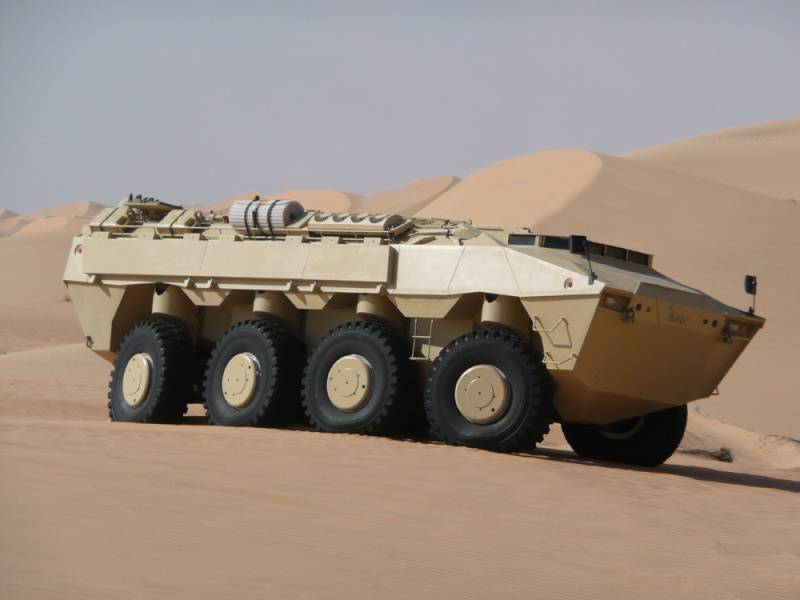
Armored PARS 8х8 during tests in the desert. Developed and manufactured by the Turkish company FNSS, it became the basis for the Malaysian BMP 8х8
If you do not take into account the developers of the project, Germany and the Netherlands, then in December 2015, the first export order was received for the Boxer 8x8 car. The starting foreign customer was Lithuania, which chose the ARTEC consortium car and began the procurement process through the OCCAR armament cooperation organization. In total, the Lithuanian army will receive 84 infantry combat vehicles equipped with UT 30 Mk2 turret from Elbit Systems, armed with 30-mm cannon and Spike missiles, as well as 4 vehicles in the command station version. Deliveries of vehicles intended for the Steel Wolf Brigade must pass from the middle of 2017 to the end of 2019. The decision was not a surprise, because there are close ties between Germany and Lithuania in the military sphere, and the choice of the Boxer machine allows for a high level of uniformity.
The decision of Lithuania was made a week before the signing of the German contract for the second batch of Boxer 131 machines. Thus, the number of Germany will reach 403 machines; in turn, the Netherlands ordered Boxer 200 machines. The second batch will consist entirely of machines of the latest configuration, developed by Artec. Deliveries will take place from the end of the 2016 year to the 2020 year.
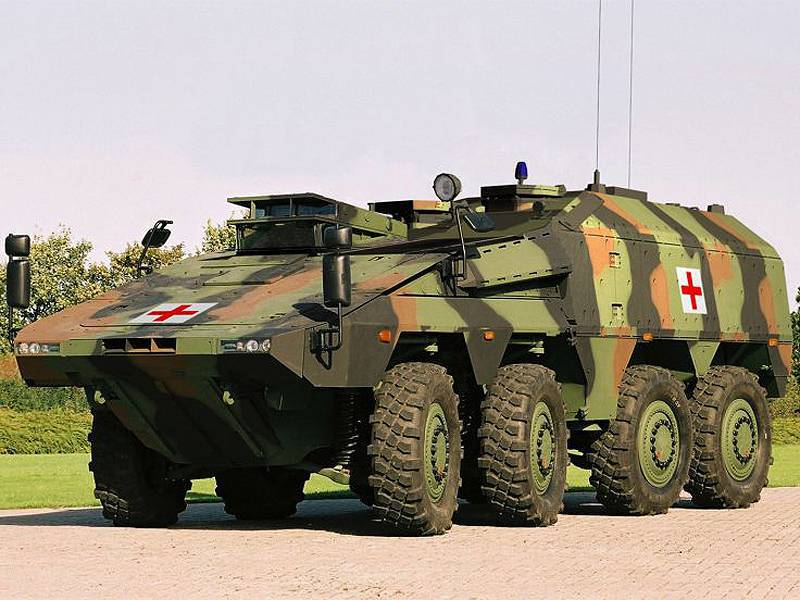
The sanitary option Boxer 8x8, developed by the ARTEC consortium (formed by KMW and Rheinmetall), recently received its first export contract
KMW and Rheinmetall offer Boxer in BMP version; Judging by the latest information, the German army seems to be interested in this system.
With regard to the national market, the supply of the German army of the first batch is completed. She currently operates 125 BTR, 72 ambulances, 65 command posts and 10 driving instruction machines. Upgrading all machines from the A1 configuration (for Afghanistan) to the A2 configuration, which includes increasing the level of protection, a new vision system for the driver, a fire extinguishing system, a satellite radio station, etc., will begin in 2017. At the same time, KMW and Rheinmetall Waffe Munition will start supplying vehicles of the second batch; The 131 deliveries of the ordered machine in the A2 configuration will end in 2020. In order to support infantry with direct fire, the German Bundeswehr is also considering the acquisition of another batch of vehicles equipped with a tower with a medium-caliber gun.
As for the Netherlands, just before the Eurosatory 2016 exhibition, half the machines ordered were delivered. The original contract provides for 60 command posts, 53 engineering vehicles, 52 ambulances, 27 trucks and 8 driving instruction. However, in May 2016, a change was made to the contract, according to which the total number of vehicles remained unchanged, but 24 command posts and 15 cargo transporters were removed, and 39 engineering group machines were added instead. In connection with their participation in the European battle group, the Netherlands must equip the Light Brigade with Boxer machines, which will require additional platforms. Like its German partner, the Dutch army is interested in the Boxer, equipped with a turret with a medium-caliber gun, but is also considering the possibility of acquiring a machine with heavier weapons.
The ARTEC consortium is currently completing some optional technical upgrades: among them a more powerful 600 kW power unit, wheels for sandy ground, a higher level of ballistic protection, new modular anti-mine screens, etc. If KMW used the Boxer chassis to install the Donar artillery module on it (two cars passed firing tests), then Rheinmetall installed the installation with a high-energy laser on the Boxer armored chassis.
The Turkish company FNSS is aggressively promoting the family of its wheeled vehicles PARS to local and foreign markets, and, as a result, in February 2016 of the year concluded another export transaction for which there is no detailed information. Based on the PARS 8x8 platform, Malaysia implements the program on its AV8 wheeled vehicle, and the local company Deftech carries out the mass production and supply of this machine. The contract provides for a total of production of 257 machines in 12 different versions; The development of half the options has already been completed, while the development of the remaining options is ongoing. FNSS is responsible for the platform itself, the Sharpshooter single-seat tower with the 25-mm cannon, and the overall system integration. The project is scheduled for completion by 2020.
At IDEF 2015, FNSS introduced the PARS 4x4, which is nominally part of the family, but structurally significantly different from the rest of its members. The machine is aimed at the STA (Silah Tasiyici Arac) armament transporter program, but since according to it only 76 units should be purchased, FNSS inevitably considers other markets. The engine of the machine is installed in the rear part to ensure optimum weight distribution, the cooling air intake is brought upwards, which allows the Pars 4x4 to enter the water without preparation, the machine is driven by two water cannons and has a height of the 350 mm surface in the water. The combat weight of the machine is 10-12 tons, and the power density varies within 25-30 hp / t. The driver and the commander are located on the two front seats, the three rear seats are arranged in a row, which ensures optimal control of the situation, also thanks to the large windshield. The winch is under the armor, while the lower inclined plate is installed at a slight angle to the vertical, which provides an angle of entry 54 °. Independent suspension with double wishbones and hydropneumatic shock absorbers together with large-diameter wheels and a tire pressure control system ensures maximum throughput and low ground pressure. The machine has a loading capacity of three tons and can take a tower weighing up to one ton. Behind the crew compartment there is space for installing the mast and radar, for example, for monitoring and reconnaissance. The machine has two rechargeable batteries, one of which is intended only for powering the onboard systems.
In order to meet the specific needs of the Turkish army, FNSS developed the PARS 4x4 machine, which, however, has little in common with other members of the family.
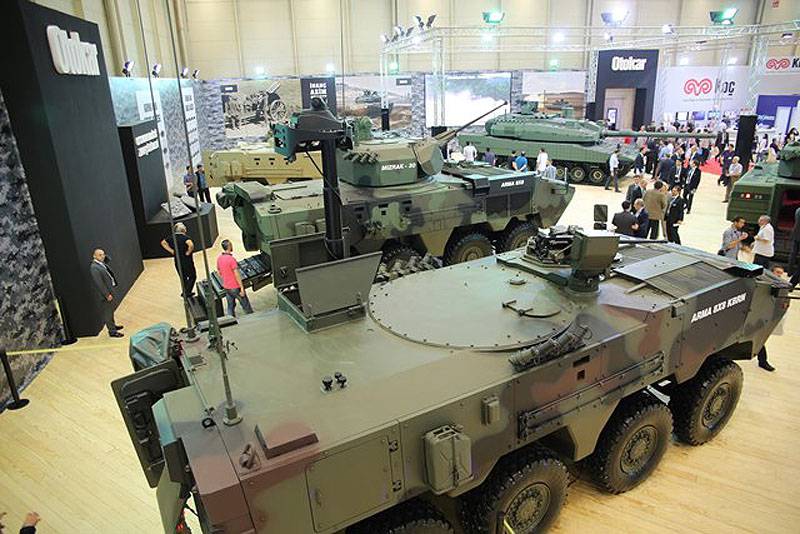
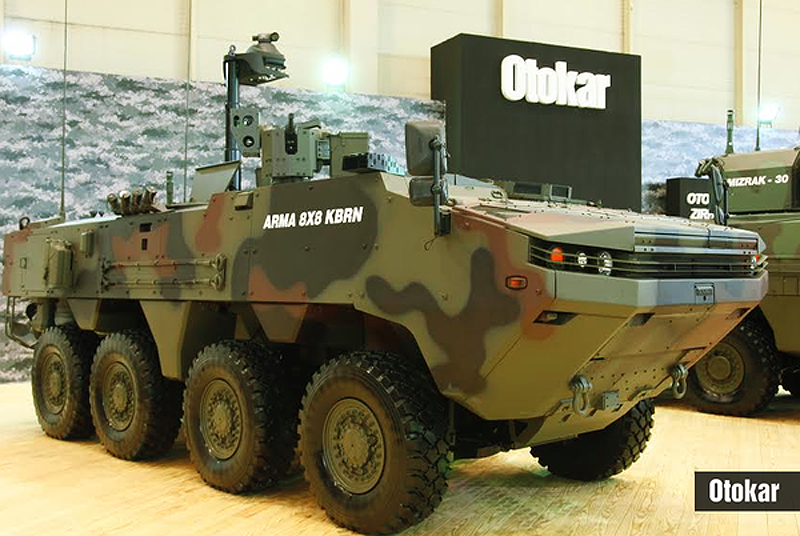
ARMA 8x8 in the configuration of the machine RCB-intelligence. Turkish company Otokar expects a new application from the Turkish army for specialized wheeled vehicles
Meanwhile, FNSS is constantly improving its wheeled vehicle configurations 6x6 and 8x8 and is currently developing a new generation of PARS, designated PARS 3. In this project, FNSS wants to increase the combat effectiveness of the machine by increasing the level of ballistic protection, increasing the net internal volume and payload, reducing maintenance requirements, and improving situational awareness while maintaining excellent running characteristics. At the moment, the PARS 3 project uses the most modern technologies, including for modifying its power unit and transmission, which allowed for a more robust design that can be adapted to a wide range of options without changing the basic systems of the machine. Thanks to its new suspension and power transmission components, the PARS 3 armored car will have a higher level of protection, accommodating more people without changing the physical signs of visibility. Since the PARS 3 is built on a modular principle, it can adapt to various tasks, including the personnel transporter, mortar set-up, reconnaissance and command variants. Its system for changing ground clearance and a flexible control system will ensure the maneuverability inherent in the PARS family. Like other members of the PARS family, the engine in the PARS 3 car is located behind the commander and driver, which allowed them to be placed in a row and thereby increase the level of ownership of the situation, not least due to the periscopic field of view, which is more than 180 °. As for the company Otokar, it is actively promoting its machines Arma 6x6 and 8x8, not forgetting to develop new configurations. The latest development here was the Arma 8x8 CBRN radiation, chemical and biological reconnaissance machine. All companies expect the Turkish army to publish an application for a specialized machine, which provides for the supply of 472 machines in 4 variants.
At present, the Terrex 8x8 armored vehicle is in service with the Singaporean army, and yet, at the DSEI 2015 exhibition, ST Kinetics presented a new version of this Terrex 2. The combat weight of the new machine has grown significantly, from 24 to 30 tons, which indicates better protection and greater payload, which has increased to 9 tons. In order to cope with such a significant increase in mass, the former Caterpillar C9 engine with a power of 450 hp. was replaced by a Caterpillar C9.3 engine with an 525 horsepower, coupled with an Allison 4500SP gearbox. Protection against explosions on mines and IEDs is enhanced by the design of the double V-shaped hull, the lower (outer) hull also protects the drives. The width has increased significantly, from 2,97 to 3,6 meters, like height, from 2,46 to 2,8 meters. The increase in volume is due to buoyancy requirements; For Terrex 2, the experience of developing a Terrex modification that meets the requirements of the US Marine Corps is used. According to this application, STK merged with the American company SAIC, and this team was one of two selected for the Marine Corps ACV1.1 program. The Terrex 2 machine is equipped with two hydraulically driven propellers with an independent thrust control system, which allowed achieving maximum speed of 6 knots, ensuring safe movement at wave heights up to 1,25 meter and landing on shore at coastal height up to 1,8 meter. Passenger capacity is three crew members and 11 paratroopers. In addition to the US application, Terrex 2 is proposed by Australia for its Land 400 Phase 2 program; In addition, STK is exploring other potential markets.
Recently, the Israeli Ministry of Defense presented a prototype of the new Eitan armored personnel carrier in an 8x8 configuration, which should replace the tracked armored personnel carriers M113, which are in service with the Israeli army. According to Israeli officials, it will be much lighter than the Namer chassis-based armored personnel carrier tank Merkava, although it should remain in the heavy segment of 8x8 wheeled vehicles, since 35 tons are likely to be the target mass of this vehicle. In this case, we can talk about the priority of defense systems, and this is not a new direction for Israel, given its rich experience in local military operations. This modular reservation, mine protection of the bottom, an active complex of protection Trophy, as well as various life support systems. The date of entry into service is scheduled for approximately 2022.
Prototype of a new Israeli Eitan armored personnel carrier in 8x8 configuration
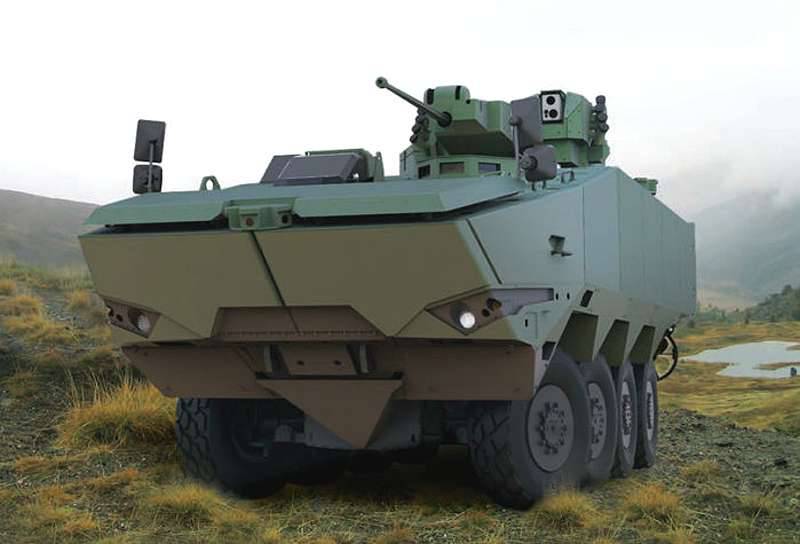
The Terrex 2 model is an evolutionary development of the previous version of Terrex, which is in service with Singapore. Together with SAIC, the Singapore STK was selected for the ACV 1.1 program of the American Marine Corps
The recent 20 order of the armored personnel carriers BTR-82A 8x8 by the armed forces of Russia shows, on the one hand, that the combination of wheeled and tracked vehicles will continue in the future, but also gives rise to vague doubts about the Boomerang 8x8 project, the first vehicles of which were first presented 9 in May 2015. Although not a lot of information is available, but in appearance the new wheeled BMP / BTR very much resembles Western cars of the same class, for example, Nexter's VBCI from CIO and Nexter VBM. The main difference is that the Boomerang is a floating machine and, as a result, the water deflector plate is installed on the front sheet, and two propellers in the stern. It is difficult to estimate its combat weight, but it should not exceed 30 tons. In the BMP version, it is equipped with a remotely controlled Epoch module (Boomerang-BM), armed with an 30-mm 2A42 cannon and Cornet missiles, while the BTR version is equipped with an anti-aircraft gun with an 12.7-mm machine gun. Up to nine paratroopers can be accommodated in the rear compartment, the aft ramp is mechanically driven, while the large door allows you to leave and get into the car without using the ramp. The driver sits in front to the left, to the right of him the engine, which significantly distinguishes the new car from the traditional layout of the previous models of Russian armored personnel carriers, in which the engine is located behind. As for sales forecasts, here it is necessary to look at the number of armored personnel carriers of the Russian army that need to be replaced.
Many countries with a need for wheeled combat vehicles, decided to develop their own platforms; sometimes completely on their own, and sometimes in cooperation with well-known foreign manufacturers. Malaysia is working on the second scheme, where the local company DRB-HICOM Defense Technologies, better known as Deftech, manufactures AV8 armored vehicles based on the Pars 8x8 chassis of the Turkish company FNSS. Emirates Defense Company Emirates Defense Company, which presented the Enigma 2015x8 infantry vehicle, developed on the basis of the Irish company Timoney chassis, also works in cooperation with a foreign partner. This chassis has all the steering wheels and the Caterpillar C8 hp 13 engine, located in front of the right and connected to the Caterpillar CXXNNX automatic transmission. The machine with the installed tower "Bakhcha" from the BMP-711 has a combat mass of 31 tons. The declared levels of protection under the NATO standard STANAG 3 correspond to the 28 (ballistic) level and 4569a / b (anti-mine) level. The machine is floating, moving on the water due to two stern propellers. A model of this vehicle was also presented in the configuration of a self-propelled artillery installation with the M4 howitzer installed by BAE Systems. The purchase of AMV cars by the UAE from the Finnish Patria put an end to this project.
India is also considering the purchase of locally developed machines. The Indian company Tata Motors showed its Kestrel project in 2014, which was developed in collaboration with the Organization for Defense Research and Development, which was once again shown in 2016, but with a different tower. Initially, the Kongsberg MCT-30R tower was installed on the Kestrel machine, whereas two years later a tower from the BMP-2 was installed on this wheeled platform. The maximum combat weight of the armored vehicle is 26 tons, lighter configurations are offered depending on the booking kit, while the basic version with the protection level 1 according to the STANAG 4569 standard has a weight of 22,5 tons. At the beginning of 2016, the Indian company Tata Motors signed an agreement on this car with Bharat Forge and US General Dynamics Land Systems (GDLS). How the program will develop in the future infantry combat vehicle Future Infantry Combat Vehicle, time will tell, especially given the delays that have already occurred. The Indian Army has a need for roughly 2600 wheeled vehicles.
New boomerang wheeled vehicle may replace BTR-82 in the Russian army
Продолжение следует ...
Articles from this series:
In the footsteps of the exhibition Eurosatory 2016: trends in the development of armored vehicles. Part of 1
In the footsteps of the exhibition Eurosatory 2016: trends in the development of armored vehicles. Part of 2
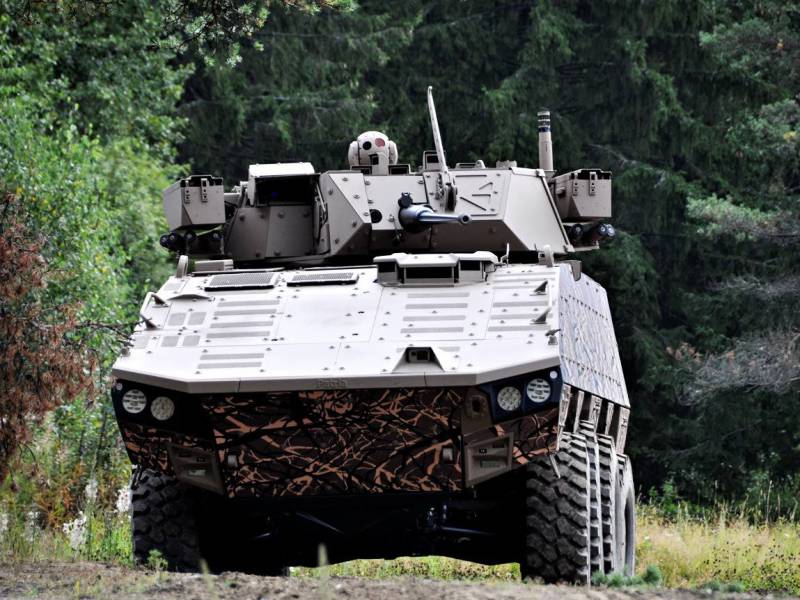
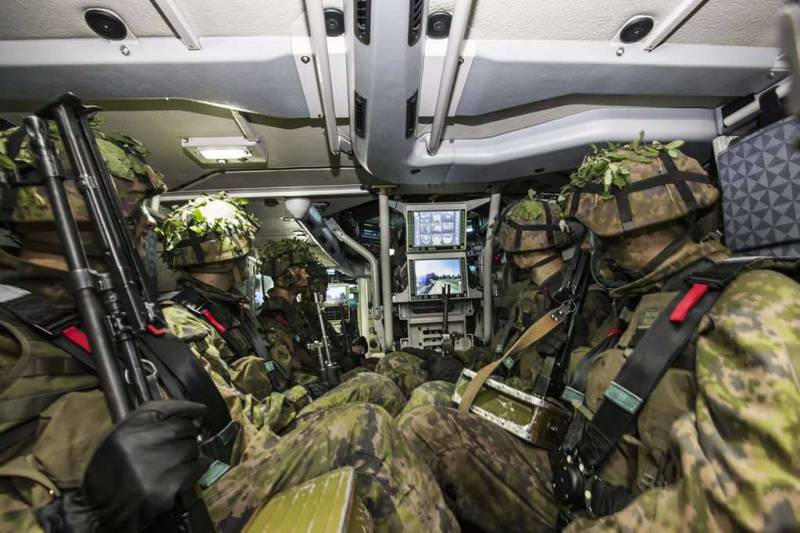
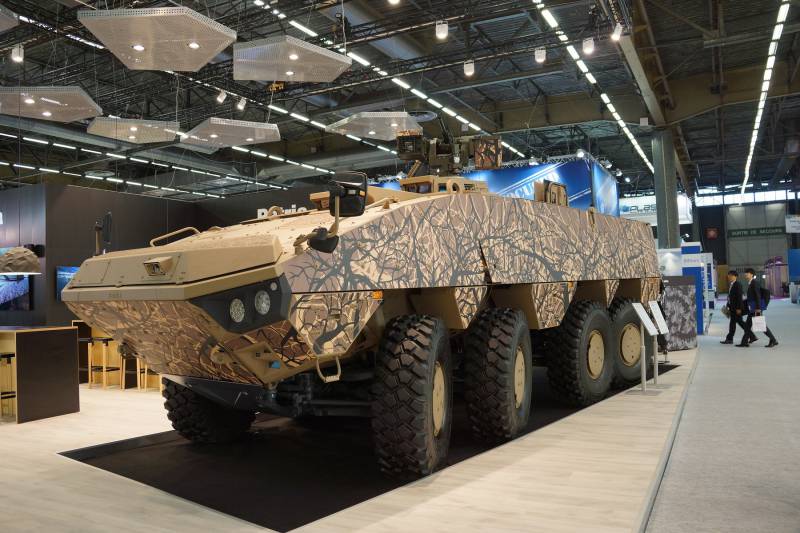
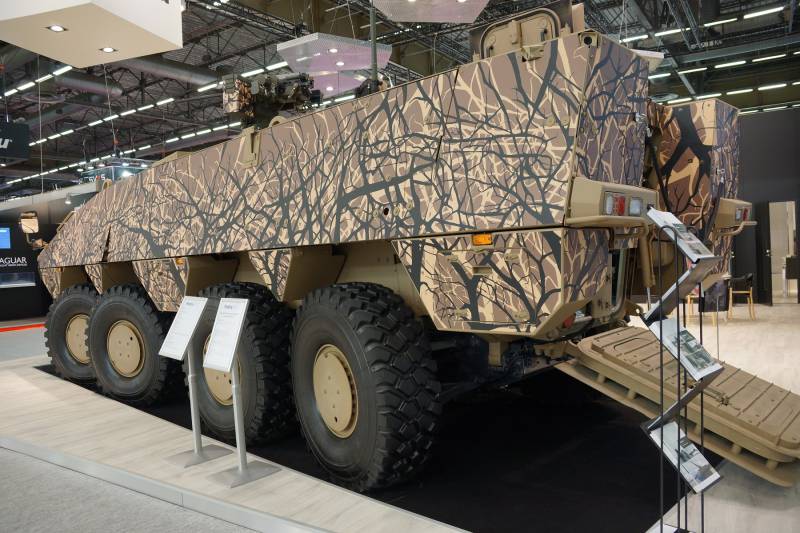
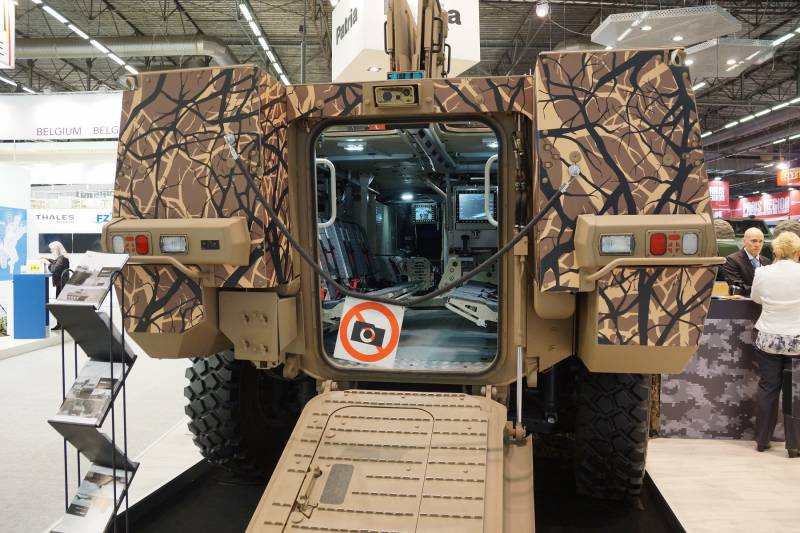
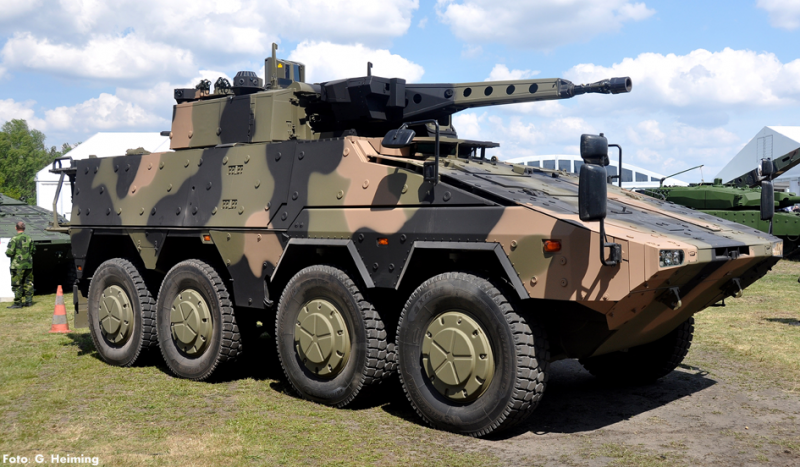
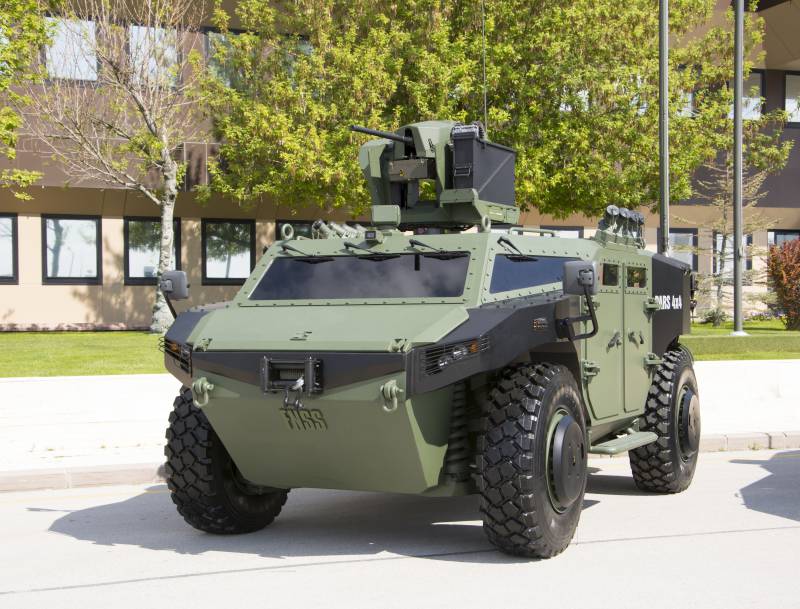
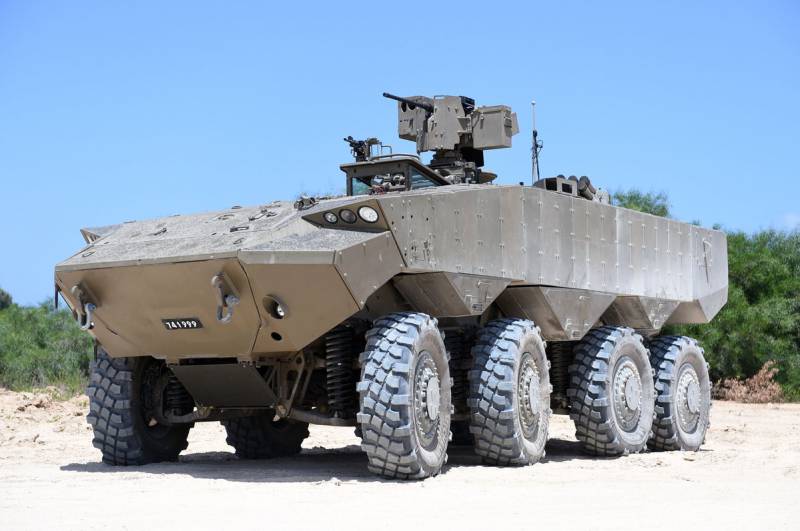
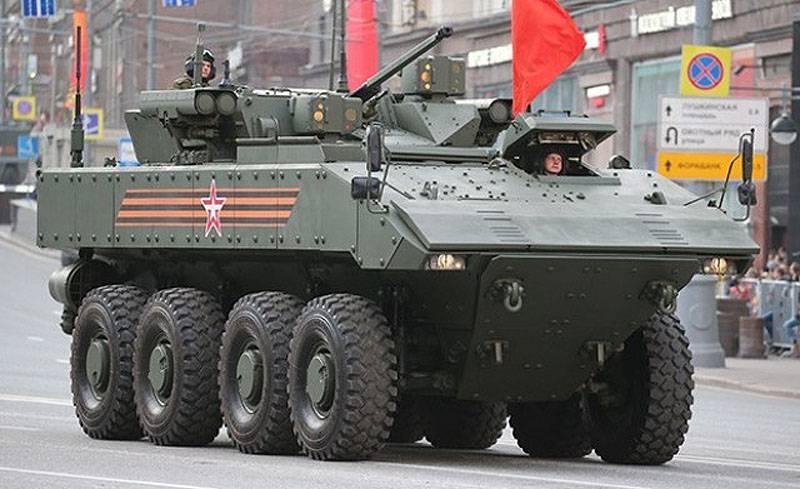
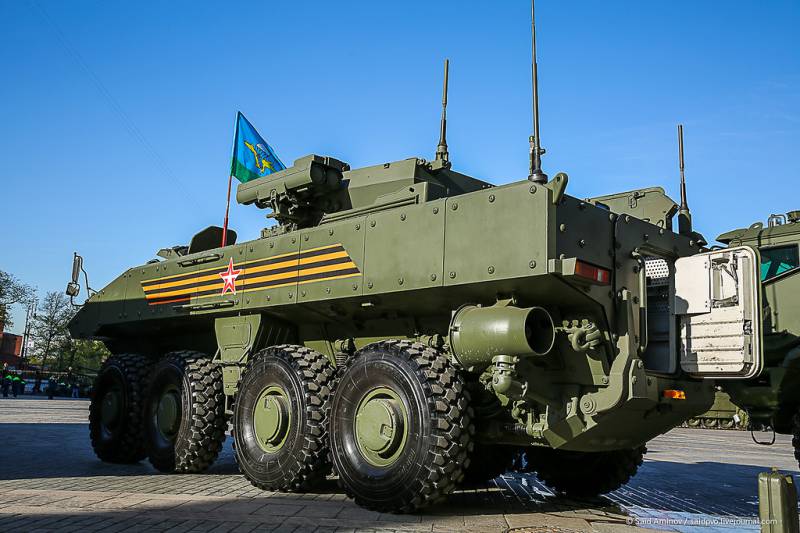
Information